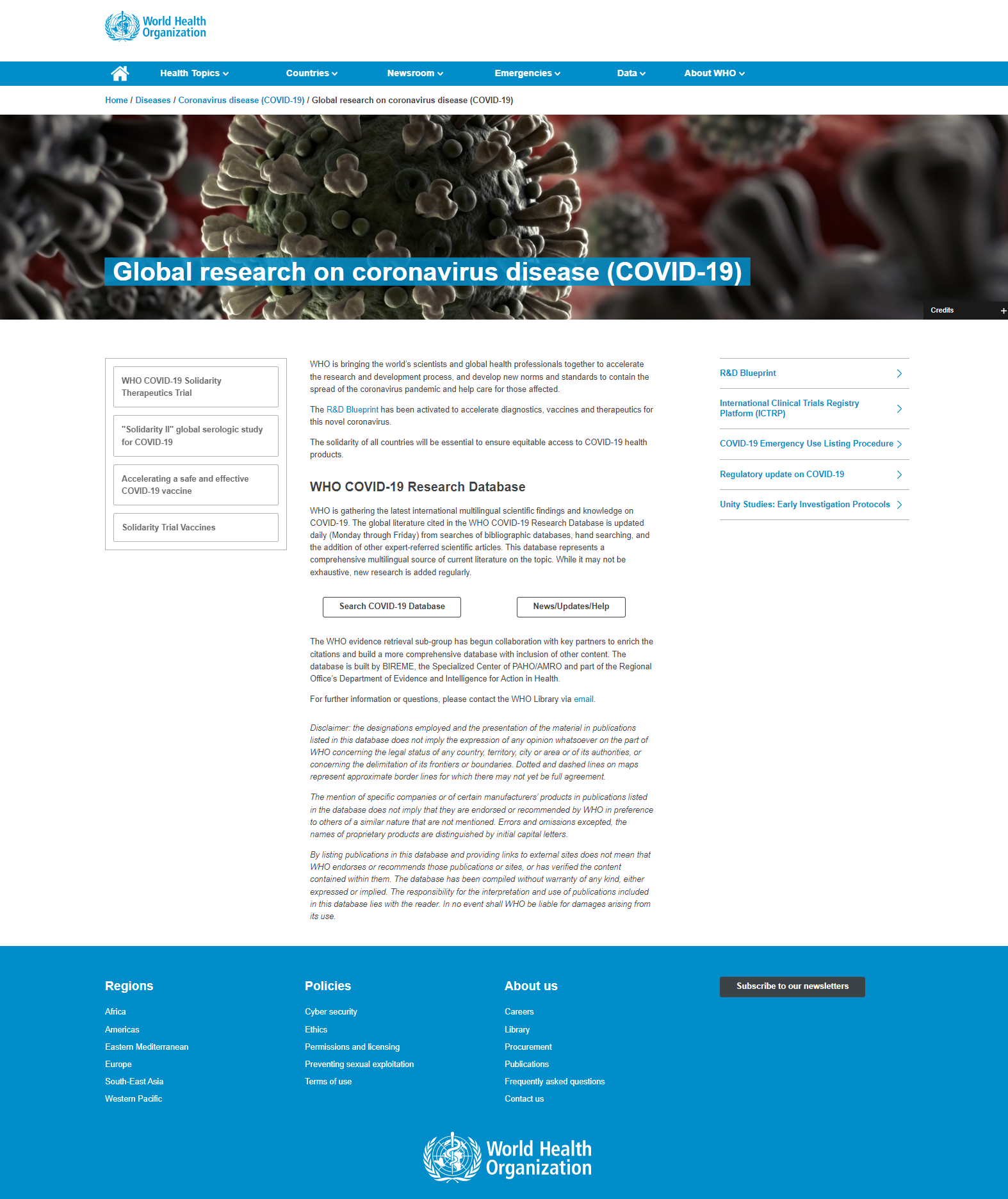
The importance of continuing to research and expand scientific knowledge to respond in particular to the global pandemic of COVID-19, underpins the continuous contribution of the Latin American and Caribbean Center on Information Sciences of the Pan American Health Organization, World Health Organization (BIREME/PAHO/WHO) alongside the WHO to strengthen the joint developments already carried out and which effectively contribute to the Strategic Plans of the Organization. Highlighting the WHO-COVID-19 Research Database, which received the American Library Association‘s Choice award with the distinction “in recognition of the value, quality and scope that would not have been possible without the tireless dedication and determination of those involved”[1].
Thus, the WHO Global COVID-19 Research Database, which is supported by BIREME/PAHO/WHO, plays a key role in facilitating and democratizing access to and use of the latest international scientific literature on COVID-19 and SARS-CoV-2. It consolidates the compilation of bibliographic citations from more than 50 information sources, resulting from collaboration with several partners, such as the Centers for Disease Control and Prevention, the United States National Library of Medicine (NLM), the Global Outbreak Alert and Response Network (GOARN) and academic publisher Elsevier. It also includes, in addition to articles published in journals, preprints[2]. It allows the user to explore relevant and up-to-date scientific literature in a single consultative place, through personalized, sensitive, and comprehensive search strategies.
This facilitation promotes diverse opportunities for innovation in the use of available information, allowing groups of researchers to apply artificial intelligence techniques such as natural language processing, machine learning and deep learning frameworks to explore biomedical semantic relationships for knowledge discovery about COVID-19. 19. The results obtained help in the generation of hypotheses, findings based on the literature, and in supporting clinical decision-making and expansion of knowledge.
The continuous growth in the number of scientific articles published also brings challenges in the effectiveness of access to knowledge and scientific discoveries described in the documents indexed in this database. Bibliographic description of journal articles, technical reports, guidelines, and other types of publication offers the possibility of dealing with a set of metadata that contains semantic relationships, such as titles and abstracts. These relationships can be extracted as semantic predications (subject, predicate and object), using available technologies such as SemRep[3],[4], a biomedical text semantic interpreter maintained by the US National Institutes of Health (NIH). Based on the Unified Medical Language System (UMLS)[5] and on the Meta-thesaurus concepts, a semantic network can be developed, providing types of predicates such as treatments, diagnoses, “administered to” and “process of” in relation to aspects of clinical medicine, or “interacts with”, inhibits and stimulates the interaction of substances, etc. With the completion of the first phase of the project, it became possible to obtain these semantic relationships based on documents indexed in the WHO Global COVID-19 Research Database.
The increasing number of documents made available through the WHO – COVID-19 Research Database requires monitoring mechanisms for early identification or changes in trends, identification of new fields of interest and concentration of research and discovery of knowledge. The infometric indicators were established based on the bibliographic description available in the database. They consider author information and affiliation, country of affiliation, country of publication, date of publication, health and biomedical issues, etc. These indicators are enriched with other information sources, text mining procedures and semantic relationships.
Following these indicators, it is possible to monitor and report on the publication of scientific and technical literature as a function of time. It is important to maintain the framework developed for monitoring infometric indicators to communicate, analyze and investigate the publication of scientific and technical literature on COVID-19 and SARS-CoV-2.
Currently, activities are under way to improve and expand the sources of information in this important Database. In addition, it is intended to provide greater robustness and flexibility to Information Architecture and data-based intelligence, in addition to intensifying the use of tools to promote knowledge, through Artificial Intelligence and Machine Learning (Semantic Analysis, External Services to automate languages, identification of models and trends, among other possibilities). In this way, the same structure could encompass other research topics, such as Monkeypox, considered by the WHO to be a public health emergency.
Related Sources
WHO Database on COVID-19 receives Choice award from American Library Association. BIREME Bulletin n. 63. Available at: https://boletin.bireme.org/en/2022/01/10/who-database-on-covid-19-receives-choice-award-from-american-library-association/
Contribution of BIREME to fight infodemia in times of COVID-19. BIREME Bulletin n. 51. Available at: https://boletin.bireme.org/en/2021/01/06/contribution-of-bireme-to-fight-infodemia-in-times-of-covid-19/
[1] WHO Database on COVID-19 wins Choice award from American Library Association. Boletim BIREME n° 63. Disponível em: https://boletin.bireme.org/en/2022/01/10/who-database-on-covid-19-receives-choice-award-from-american-library-association/
[2] Preprints from bioRxiv – https://biorxiv.org/ and medRxiv – https://medrxiv.org/
[3] Semantic Knowledge Representation. National Institutes of Health. Available at: https://semrep.nlm.nih.gov/
[4] Kilicoglu H. et al. 2012. SemMedDB. A PubMed-scale repository of biomedical semantic predications. Bioinformatics (23):3158-3160. https://doi.org/10.1093/bioinformatics/bts591
[5] Unified Medical Language System. National Institutes of Health. Available at: https://www.nlm.nih.gov/research/umls/index.html




